当前位置:网站首页>Data Lake (13): spark and iceberg integrate DDL operations
Data Lake (13): spark and iceberg integrate DDL operations
2022-07-04 14:28:00 【Lansonli】

List of articles
Spark And Iceberg Integrate DDL operation
One 、CREATE TABLE Create table
Two 、CREATE TAEBL ... AS SELECT
1、 Create table hadoop_prod.default.mytbl, And insert data
2、 Use “create table ... as select” Syntax create table mytal2 And query
3、 ... and 、REPLACE TABLE ... AS SELECT
1、 Create table “hadoop_prod.default.mytbl3”, And insert data 、 Exhibition
2、 Rebuild table “hadoop_prod.default.mytbl3”, And insert the corresponding data
Four 、DROP TABLE
6、 ... and 、ALTER TABLE Partition operation
1、 Create table mytbl, And insert data
2、 Will table loc Columns are added as partition columns , And insert data , Inquire about
3、 take ts Columns are converted as partition columns , Insert data and query
Spark And Iceberg Integrate DDL operation
Use here Hadoop Catalog To demonstrate Spark And Iceberg Of DDL operation .
One 、CREATE TABLE Create table
Create table establish Iceberg surface , Creating tables can not only create ordinary tables, but also create partitioned tables , When inserting a batch of data into the partition table , The partitioned columns in the data must be sorted , Otherwise, a file closing error will appear , The code is as follows :
val spark: SparkSession = SparkSession.builder().master("local").appName("SparkOperateIceberg")
// Appoint hadoop catalog,catalog The name is hadoop_prod
.config("spark.sql.catalog.hadoop_prod", "org.apache.iceberg.spark.SparkCatalog")
.config("spark.sql.catalog.hadoop_prod.type", "hadoop")
.config("spark.sql.catalog.hadoop_prod.warehouse", "hdfs://mycluster/sparkoperateiceberg")
.getOrCreate()
// Create a normal table
spark.sql(
"""
| create table if not exists hadoop_prod.default.normal_tbl(id int,name string,age int) using iceberg
""".stripMargin)
// Create a partition table , With loc Column as partition field
spark.sql(
"""
|create table if not exists hadoop_prod.default.partition_tbl(id int,name string,age int,loc string) using iceberg partitioned by (loc)
""".stripMargin)
// When inserting data into a partitioned table , Partition columns must be sorted , Otherwise, the report will be wrong :java.lang.IllegalStateException: Already closed files for partition:xxx
spark.sql(
"""
|insert into table hadoop_prod.default.partition_tbl values (1,"zs",18,"beijing"),(3,"ww",20,"beijing"),(2,"ls",19,"shanghai"),(4,"ml",21,"shagnhai")
""".stripMargin)
spark.sql("select * from hadoop_prod.default.partition_tbl").show()The query results are as follows :
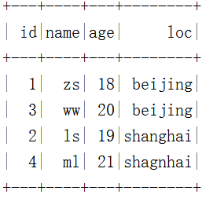
establish Iceberg In zoning , You can also use some conversion expressions to timestamp Column to convert , establish Hide partition , Common conversion expressions are as follows :
- years(ts): By year
// Create a partition table partition_tbl1 , Specify partition as year
spark.sql(
"""
|create table if not exists hadoop_prod.default.partition_tbl1(id int ,name string,age int,regist_ts timestamp) using iceberg
|partitioned by (years(regist_ts))
""".stripMargin)
// Insert data into table , Be careful , The inserted data needs to be sorted in advance , It has to be sorted , As long as the data of the same date are written together
//(1,'zs',18,1608469830) --"2020-12-20 21:10:30"
//(2,'ls',19,1634559630) --"2021-10-18 20:20:30"
//(3,'ww',20,1603096230) --"2020-10-19 16:30:30"
//(4,'ml',21,1639920630) --"2021-12-19 21:30:30"
//(5,'tq',22,1608279630) --"2020-12-18 16:20:30"
//(6,'gb',23,1576843830) --"2019-12-20 20:10:30"
spark.sql(
"""
|insert into hadoop_prod.default.partition_tbl1 values
|(1,'zs',18,cast(1608469830 as timestamp)),
|(3,'ww',20,cast(1603096230 as timestamp)),
|(5,'tq',22,cast(1608279630 as timestamp)),
|(2,'ls',19,cast(1634559630 as timestamp)),
|(4,'ml',21,cast(1639920630 as timestamp)),
|(6,'gb',23,cast(1576843830 as timestamp))
""".stripMargin)
// Query results
spark.sql(
"""
|select * from hadoop_prod.default.partition_tbl1
""".stripMargin).show()The results are as follows :
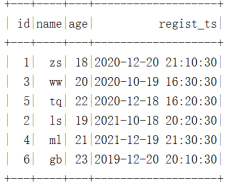
stay HDFS Middle is divided by year :

- months(ts): according to “ year - month ” Monthly level partition
// Create a partition table partition_tbl2 , Specify partition as months, According to “ year - month ” Partition
spark.sql(
"""
|create table if not exists hadoop_prod.default.partition_tbl2(id int ,name string,age int,regist_ts timestamp) using iceberg
|partitioned by (months(regist_ts))
""".stripMargin)
// Insert data into table , Be careful , The inserted data needs to be sorted in advance , It has to be sorted , As long as the data of the same date are written together
//(1,'zs',18,1608469830) --"2020-12-20 21:10:30"
//(2,'ls',19,1634559630) --"2021-10-18 20:20:30"
//(3,'ww',20,1603096230) --"2020-10-19 16:30:30"
//(4,'ml',21,1639920630) --"2021-12-19 21:30:30"
//(5,'tq',22,1608279630) --"2020-12-18 16:20:30"
//(6,'gb',23,1576843830) --"2019-12-20 20:10:30"
spark.sql(
"""
|insert into hadoop_prod.default.partition_tbl2 values
|(1,'zs',18,cast(1608469830 as timestamp)),
|(5,'tq',22,cast(1608279630 as timestamp)),
|(2,'ls',19,cast(1634559630 as timestamp)),
|(3,'ww',20,cast(1603096230 as timestamp)),
|(4,'ml',21,cast(1639920630 as timestamp)),
|(6,'gb',23,cast(1576843830 as timestamp))
""".stripMargin)
// Query results
spark.sql(
"""
|select * from hadoop_prod.default.partition_tbl2
""".stripMargin).show()The results are as follows :
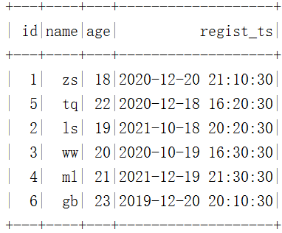
stay HDFS Is in accordance with the “ year - month ” partition :

- days(ts) perhaps date(ts): according to “ year - month - Japan ” Day level partition
// Create a partition table partition_tbl3 , Specify partition as days, According to “ year - month - Japan ” Partition
spark.sql(
"""
|create table if not exists hadoop_prod.default.partition_tbl3(id int ,name string,age int,regist_ts timestamp) using iceberg
|partitioned by (days(regist_ts))
""".stripMargin)
// Insert data into table , Be careful , The inserted data needs to be sorted in advance , It has to be sorted , As long as the data of the same date are written together
//(1,'zs',18,1608469830) --"2020-12-20 21:10:30"
//(2,'ls',19,1634559630) --"2021-10-18 20:20:30"
//(3,'ww',20,1603096230) --"2020-10-19 16:30:30"
//(4,'ml',21,1639920630) --"2021-12-19 21:30:30"
//(5,'tq',22,1608279630) --"2020-12-18 16:20:30"
//(6,'gb',23,1576843830) --"2019-12-20 20:10:30"
spark.sql(
"""
|insert into hadoop_prod.default.partition_tbl3 values
|(1,'zs',18,cast(1608469830 as timestamp)),
|(5,'tq',22,cast(1608279630 as timestamp)),
|(2,'ls',19,cast(1634559630 as timestamp)),
|(3,'ww',20,cast(1603096230 as timestamp)),
|(4,'ml',21,cast(1639920630 as timestamp)),
|(6,'gb',23,cast(1576843830 as timestamp))
""".stripMargin)
// Query results
spark.sql(
"""
|select * from hadoop_prod.default.partition_tbl3
""".stripMargin).show()The results are as follows :
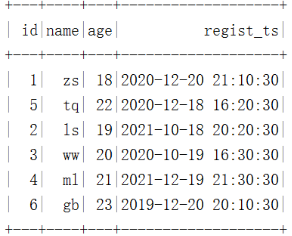
stay HDFS Is in accordance with the “ year - month - Japan ” partition :

- hours(ts) perhaps date_hour(ts): according to “ year - month - Japan - when ” Hour level partition
// Create a partition table partition_tbl4 , Specify partition as hours, According to “ year - month - Japan - when ” Partition
spark.sql(
"""
|create table if not exists hadoop_prod.default.partition_tbl4(id int ,name string,age int,regist_ts timestamp) using iceberg
|partitioned by (hours(regist_ts))
""".stripMargin)
// Insert data into table , Be careful , The inserted data needs to be sorted in advance , It has to be sorted , As long as the data of the same date are written together
//(1,'zs',18,1608469830) --"2020-12-20 21:10:30"
//(2,'ls',19,1634559630) --"2021-10-18 20:20:30"
//(3,'ww',20,1603096230) --"2020-10-19 16:30:30"
//(4,'ml',21,1639920630) --"2021-12-19 21:30:30"
//(5,'tq',22,1608279630) --"2020-12-18 16:20:30"
//(6,'gb',23,1576843830) --"2019-12-20 20:10:30"
spark.sql(
"""
|insert into hadoop_prod.default.partition_tbl4 values
|(1,'zs',18,cast(1608469830 as timestamp)),
|(5,'tq',22,cast(1608279630 as timestamp)),
|(2,'ls',19,cast(1634559630 as timestamp)),
|(3,'ww',20,cast(1603096230 as timestamp)),
|(4,'ml',21,cast(1639920630 as timestamp)),
|(6,'gb',23,cast(1576843830 as timestamp))
""".stripMargin)
// Query results
spark.sql(
"""
|select * from hadoop_prod.default.partition_tbl4
""".stripMargin).show()The results are as follows :
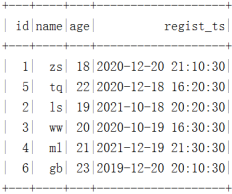
stay HDFS Is in accordance with the “ year - month - Japan - when ” partition :

Iceberg The supported time partitions currently and in the future only support UTC,UTC It's international time ,UTC+8 It's international time plus eight hours , It's East eighth District time , It's Beijing time , So we can see that the partition time above is inconsistent with the data time .
In addition to the above commonly used time hidden partitions ,Iceberg And support bucket(N,col) Partition , This partitioning method can be based on hash Value and N The remainder determines the partition to which the data goes .truncate(L,col), This hidden partition can intercept the string of characters L length , The same data will be divided into the same partition .
Two 、CREATE TAEBL ... AS SELECT
Iceberg Support “create table .... as select ” grammar , You can create a table from the query statement , And insert the corresponding data , The operation is as follows :
1、 Create table hadoop_prod.default.mytbl, And insert data
val spark: SparkSession = SparkSession.builder().master("local").appName("SparkOperateIceberg")
// Appoint hadoop catalog,catalog The name is hadoop_prod
.config("spark.sql.catalog.hadoop_prod", "org.apache.iceberg.spark.SparkCatalog")
.config("spark.sql.catalog.hadoop_prod.type", "hadoop")
.config("spark.sql.catalog.hadoop_prod.warehouse", "hdfs://mycluster/sparkoperateiceberg")
.getOrCreate()
// Create a normal table
spark.sql(
"""
| create table hadoop_prod.default.mytbl(id int,name string,age int) using iceberg
""".stripMargin)
// Insert data into table
spark.sql(
"""
|insert into table hadoop_prod.default.mytbl values (1,"zs",18),(3,"ww",20),(2,"ls",19),(4,"ml",21)
""".stripMargin)
// Query data
spark.sql("select * from hadoop_prod.default.mytbl").show()2、 Use “create table ... as select” Syntax create table mytal2 And query
spark.sql(
"""
|create table hadoop_prod.default.mytbl2 using iceberg as select id,name,age from hadoop_prod.default.mytbl
""".stripMargin)
spark.sql(
"""
|select * from hadoop_prod.default.mytbl2
""".stripMargin).show()give the result as follows :
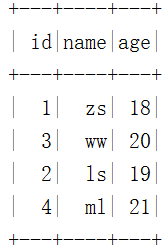
3、 ... and 、REPLACE TABLE ... AS SELECT
Iceberg Support “replace table .... as select ” grammar , You can rebuild a table from the query statement , And insert the corresponding data , The operation is as follows :
1、 Create table “hadoop_prod.default.mytbl3”, And insert data 、 Exhibition
spark.sql(
"""
|create table hadoop_prod.default.mytbl3 (id int,name string,loc string,score int) using iceberg
""".stripMargin)
spark.sql(
"""
|insert into table hadoop_prod.default.mytbl3 values (1,"zs","beijing",100),(2,"ls","shanghai",200)
""".stripMargin)
spark.sql(
"""
|select * from hadoop_prod.default.mytbl3
""".stripMargin).show 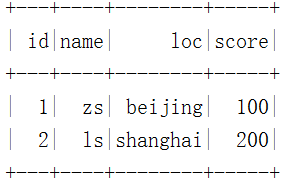
2、 Rebuild table “hadoop_prod.default.mytbl3”, And insert the corresponding data
spark.sql(
"""
|replace table hadoop_prod.default.mytbl2 using iceberg as select * from hadoop_prod.default.mytbl3
""".stripMargin)
spark.sql(
"""
|select * from hadoop_prod.default.mytbl2
""".stripMargin).show()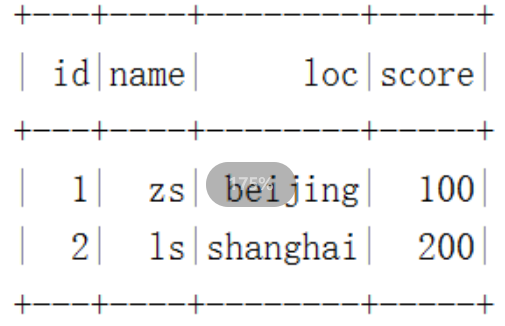
Four 、DROP TABLE
Delete iceberg Table is executed directly :“drop table xxx” Sentence can be used , When deleting a table , The table data will be deleted , But the library directory exists .
// Delete table
spark.sql(
"""
|drop table hadoop_prod.default.mytbl
""".stripMargin) 
5、 ... and 、ALTER TABLE
Iceberg Of alter Operation in Spark3.x Version supports ,alter It generally includes the following operations :
- add to 、 Delete column
Add column operation :ALTER TABLE ... ADD COLUMN
Delete column operation :ALTER TABLE ... DROP COLUMN
//1. Create table test, And insert data 、 Inquire about
spark.sql(
"""
|create table hadoop_prod.default.test(id int,name string,age int) using iceberg
""".stripMargin)
spark.sql(
"""
|insert into table hadoop_prod.default.test values (1,"zs",18),(2,"ls",19),(3,"ww",20)
""".stripMargin)
spark.sql(
"""
| select * from hadoop_prod.default.test
""".stripMargin).show()
//2. Add fields , to test Table increase gender Column 、loc Column
spark.sql(
"""
|alter table hadoop_prod.default.test add column gender string,loc string
""".stripMargin)
//3. Delete field , to test Table delete age Column
spark.sql(
"""
|alter table hadoop_prod.default.test drop column age
""".stripMargin)
//4. See the table test data
spark.sql(
"""
|select * from hadoop_prod.default.test
""".stripMargin).show()The final table shows fewer columns age Column , More gender、loc Column :
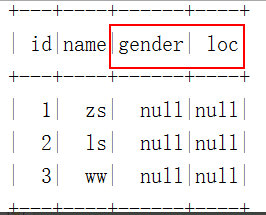
- To be ranked high
Rename the syntax :ALTER TABLE ... RENAME COLUMN, The operation is as follows :
//5. To be ranked high
spark.sql(
"""
|alter table hadoop_prod.default.test rename column gender to xxx
|
""".stripMargin)
spark.sql(
"""
|select * from hadoop_prod.default.test
""".stripMargin).show()The columns shown in the final table gender The column becomes xxx Column :
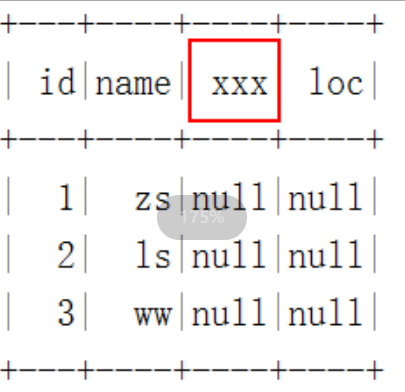
6、 ... and 、ALTER TABLE Partition operation
alter Partition operations include adding partitions and deleting partitions , This partition operation is in Spark3.x Later supported ,spark2.4 Version not supported , And when you use it , Must be in spark Add... To the configuration spark.sql.extensions attribute , Its value is :org.apache.iceberg.spark.extensions.IcebergSparkSessionExtensions, Partition conversion is also supported when adding partitions , The grammar is as follows :
- Add partition syntax :ALTER TABLE ... ADD PARTITION FIELD
- Delete partition Syntax :ALTER TABLE ... DROP PARTITION FIELD
The specific operation is as follows :
1、 Create table mytbl, And insert data
val spark: SparkSession = SparkSession.builder().master("local").appName("SparkOperateIceberg")
// Appoint hadoop catalog,catalog The name is hadoop_prod
.config("spark.sql.catalog.hadoop_prod", "org.apache.iceberg.spark.SparkCatalog")
.config("spark.sql.catalog.hadoop_prod.type", "hadoop")
.config("spark.sql.catalog.hadoop_prod.warehouse", "hdfs://mycluster/sparkoperateiceberg")
.config("spark.sql.extensions","org.apache.iceberg.spark.extensions.IcebergSparkSessionExtensions")
.getOrCreate()
//1. Create a normal table
spark.sql(
"""
| create table hadoop_prod.default.mytbl(id int,name string,loc string,ts timestamp) using iceberg
""".stripMargin)
//2. Insert data into table , And query
spark.sql(
"""
|insert into hadoop_prod.default.mytbl values
|(1,'zs',"beijing",cast(1608469830 as timestamp)),
|(3,'ww',"shanghai",cast(1603096230 as timestamp))
""".stripMargin)
spark.sql("select * from hadoop_prod.default.mytbl").show()stay HDFS The data storage and results in are as follows :

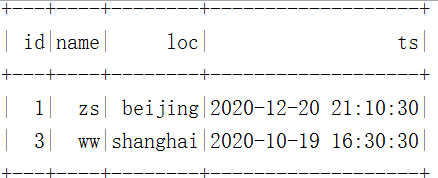
2、 Will table loc Columns are added as partition columns , And insert data , Inquire about
//3. take loc Columns are added as partitions , You must add config("spark.sql.extensions", "org.apache.iceberg.spark.extensions.IcebergSparkSessionExtensions") To configure
spark.sql(
"""
|alter table hadoop_prod.default.mytbl add partition field loc
""".stripMargin)
//4. To watch mytbl Continue inserting data in , Previously, the data was not partitioned , After that, the data is partitioned
spark.sql(
"""
|insert into hadoop_prod.default.mytbl values
|(5,'tq',"hangzhou",cast(1608279630 as timestamp)),
|(2,'ls',"shandong",cast(1634559630 as timestamp))
""".stripMargin )
spark.sql("select * from hadoop_prod.default.mytbl").show()stay HDFS The data storage and results in are as follows :

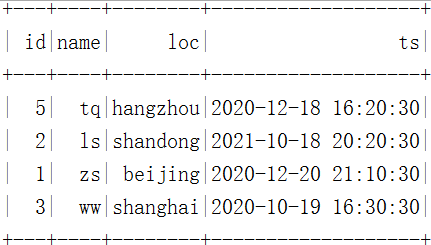
Be careful : Adding partition fields is a metadata operation , The existing table data will not be changed , New data will be written using the new partition , Existing data will remain in the original layout .
3、 take ts Columns are converted as partition columns , Insert data and query
//5. take ts Columns are added as partition columns by partition transformation
spark.sql(
"""
|alter table hadoop_prod.default.mytbl add partition field years(ts)
""".stripMargin)
//6. To watch mytbl Continue inserting data in , Previously, the data was not partitioned , After that, the data is partitioned
spark.sql(
"""
|insert into hadoop_prod.default.mytbl values
|(4,'ml',"beijing",cast(1639920630 as timestamp)),
|(6,'gb',"tianjin",cast(1576843830 as timestamp))
""".stripMargin )
spark.sql("select * from hadoop_prod.default.mytbl").show()stay HDFS The data storage and results in are as follows :

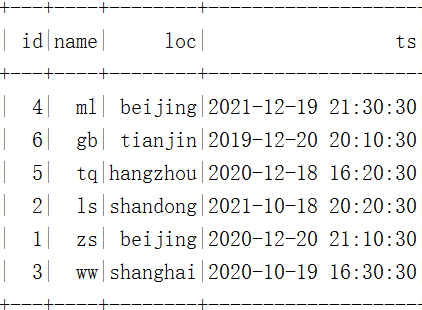
4、 Delete partition loc
//7. Delete table mytbl Medium loc Partition
spark.sql(
"""
|alter table hadoop_prod.default.mytbl drop partition field loc
""".stripMargin)
//8. Go on to the table mytbl Insert data , And query
spark.sql(
"""
|insert into hadoop_prod.default.mytbl values
|(4,'ml',"beijing",cast(1639920630 as timestamp)),
|(6,'gb',"tianjin",cast(1576843830 as timestamp))
""".stripMargin )
spark.sql("select * from hadoop_prod.default.mytbl").show()stay HDFS The data storage and results in are as follows :

Be careful : Because there are ts The corresponding partition after partition conversion , So continue inserting data loc Zoning null
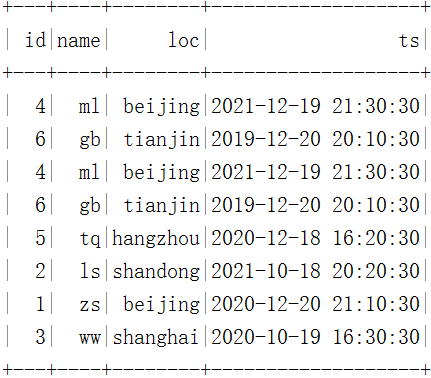
5、 Delete partition years(ts)
//9. Delete table mytbl Medium years(ts) Partition
spark.sql(
"""
|alter table hadoop_prod.default.mytbl drop partition field years(ts)
""".stripMargin)
//10. Go on to the table mytbl Insert data , And query
spark.sql(
"""
|insert into hadoop_prod.default.mytbl values
|(5,'tq',"hangzhou",cast(1608279630 as timestamp)),
|(2,'ls',"shandong",cast(1634559630 as timestamp))
""".stripMargin )
spark.sql("select * from hadoop_prod.default.mytbl").show()stay HDFS The data storage and results in are as follows :

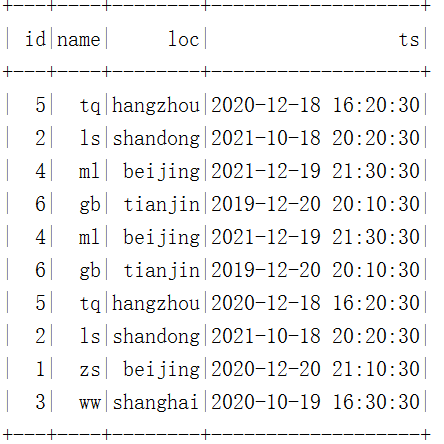
- Blog home page :https://lansonli.blog.csdn.net
- Welcome to thumb up Collection Leaving a message. Please correct any mistakes !
- This paper is written by Lansonli original , First appeared in CSDN Blog
- When you stop to rest, don't forget that others are still running , I hope you will seize the time to learn , Go all out for a better life
边栏推荐
- Scratch Castle Adventure Electronic Society graphical programming scratch grade examination level 3 true questions and answers analysis June 2022
- 数据湖(十三):Spark与Iceberg整合DDL操作
- What is the difference between Bi financial analysis in a narrow sense and financial analysis in a broad sense?
- Ml: introduction, principle, use method and detailed introduction of classic cases of snap value
- 递增的三元子序列[贪心训练]
- MySQL的触发器
- Progress in architecture
- Solutions aux problèmes d'utilisation de l'au ou du povo 2 dans le riz rouge k20pro MIUI 12.5
- Test process arrangement (2)
- Ruiji takeout notes
猜你喜欢
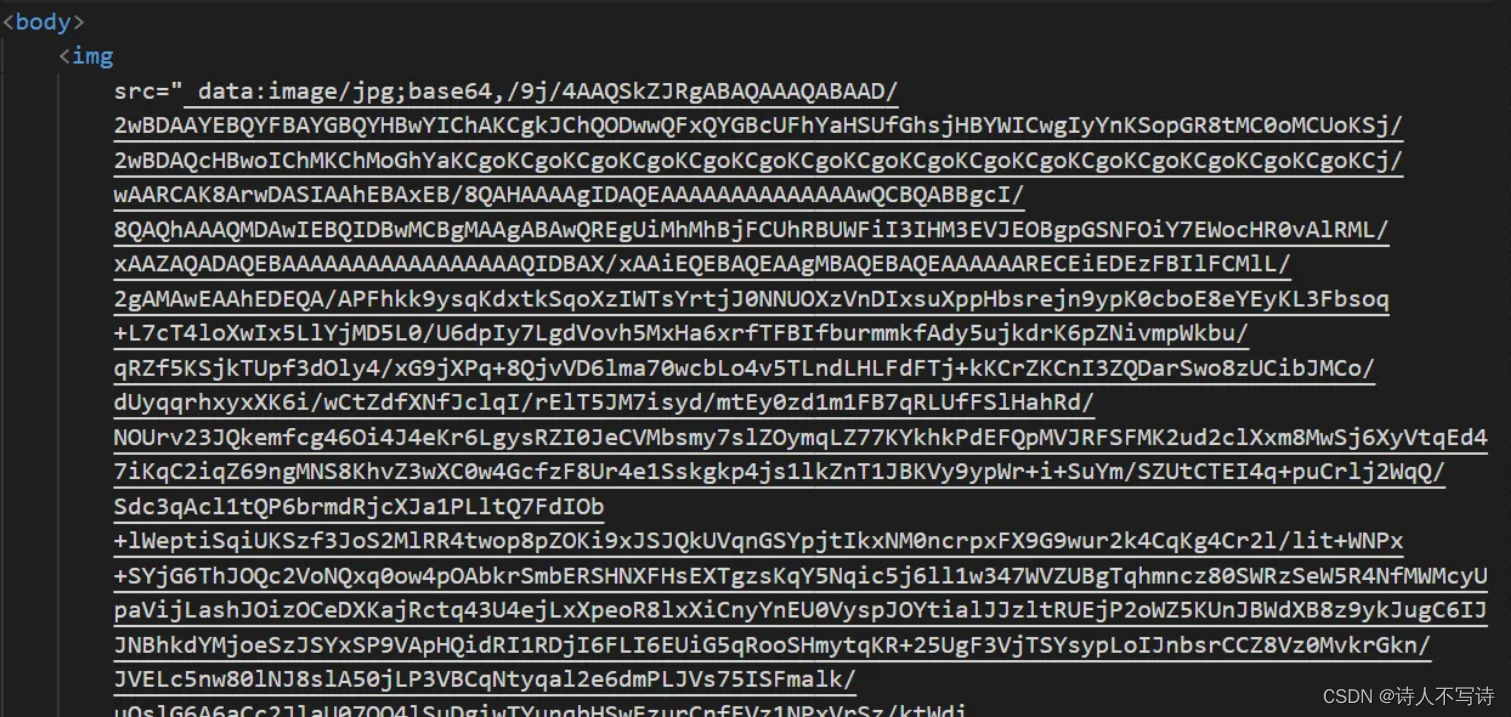
Why should Base64 encoding be used for image transmission
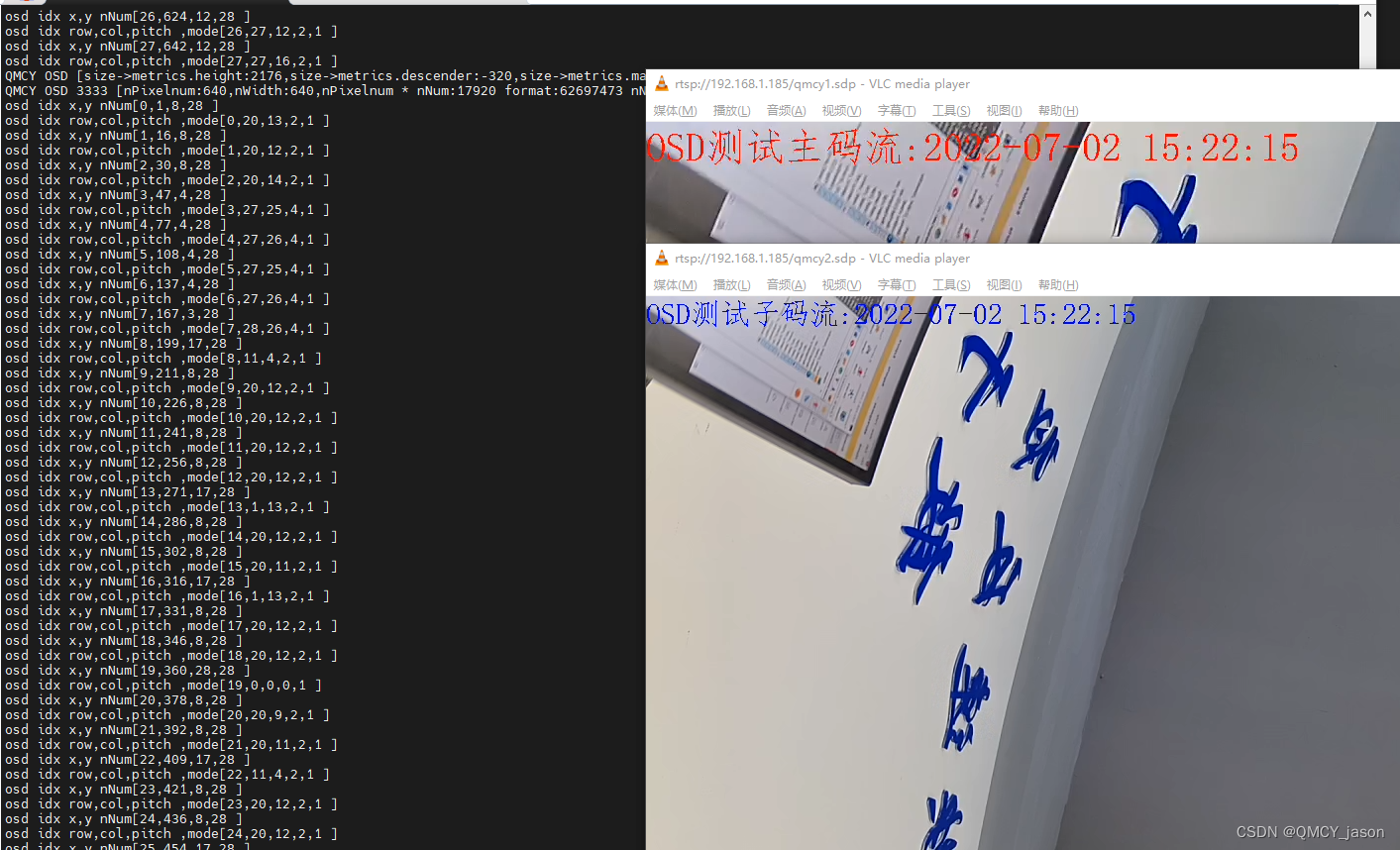
RK1126平台OSD的实现支持颜色半透明度多通道支持中文

The implementation of OSD on rk1126 platform supports color translucency and multi-channel support for Chinese
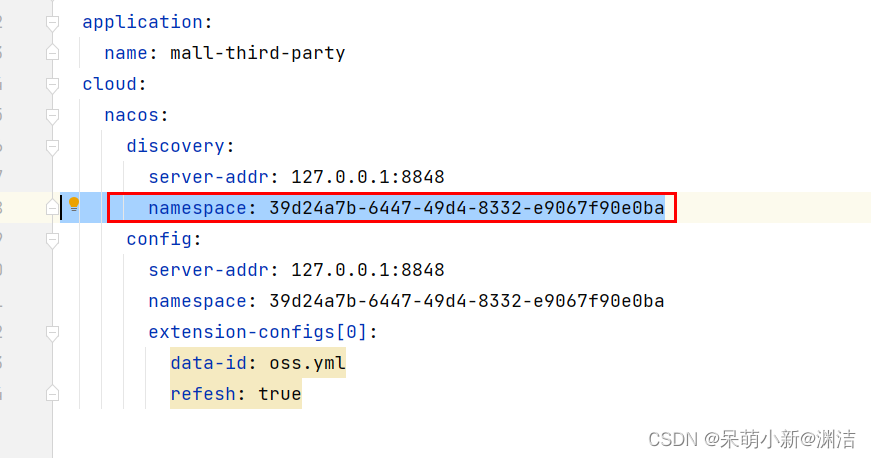
No servers available for service: xxxx
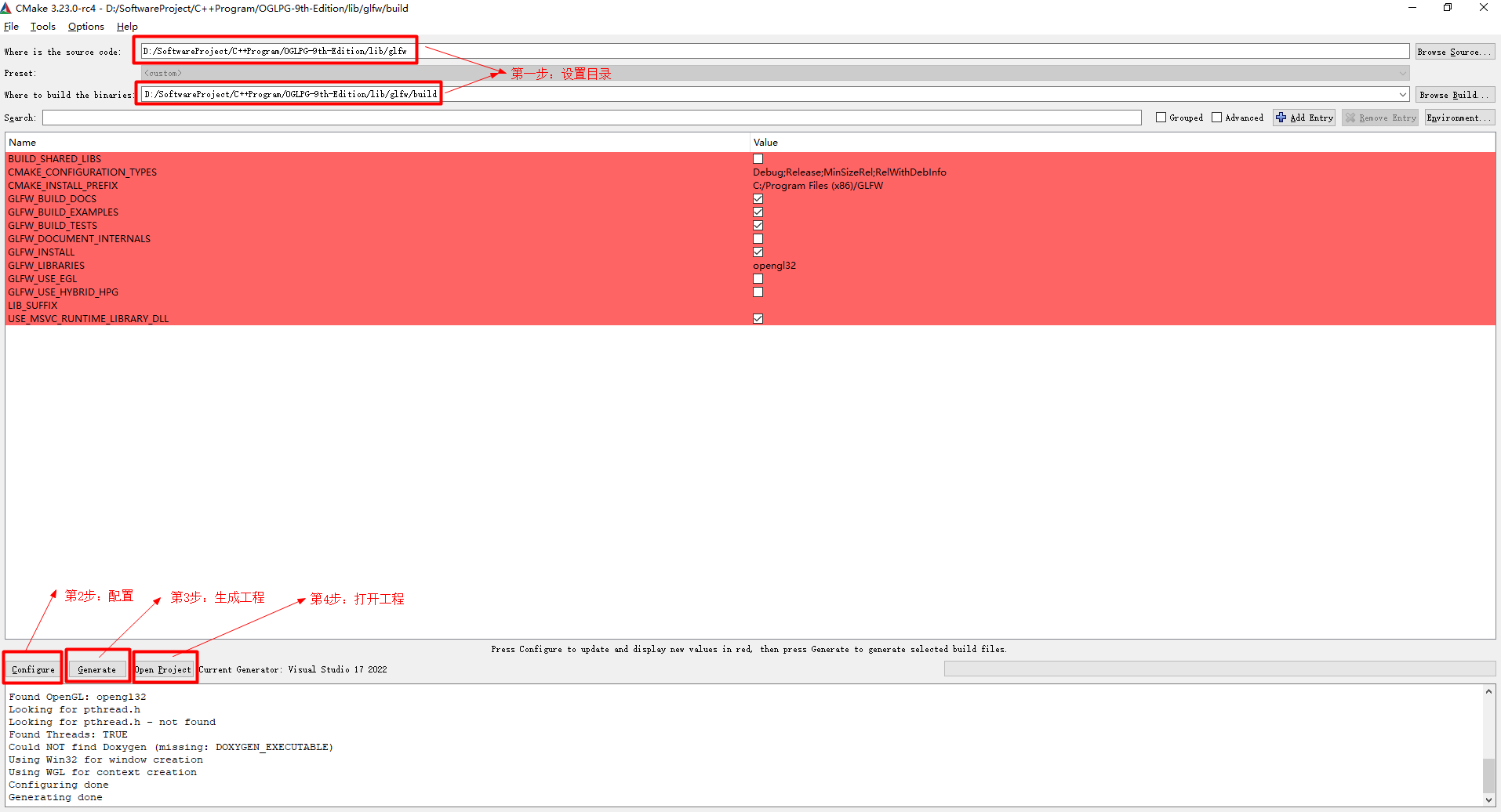
Compile oglpg-9th-edition source code with clion
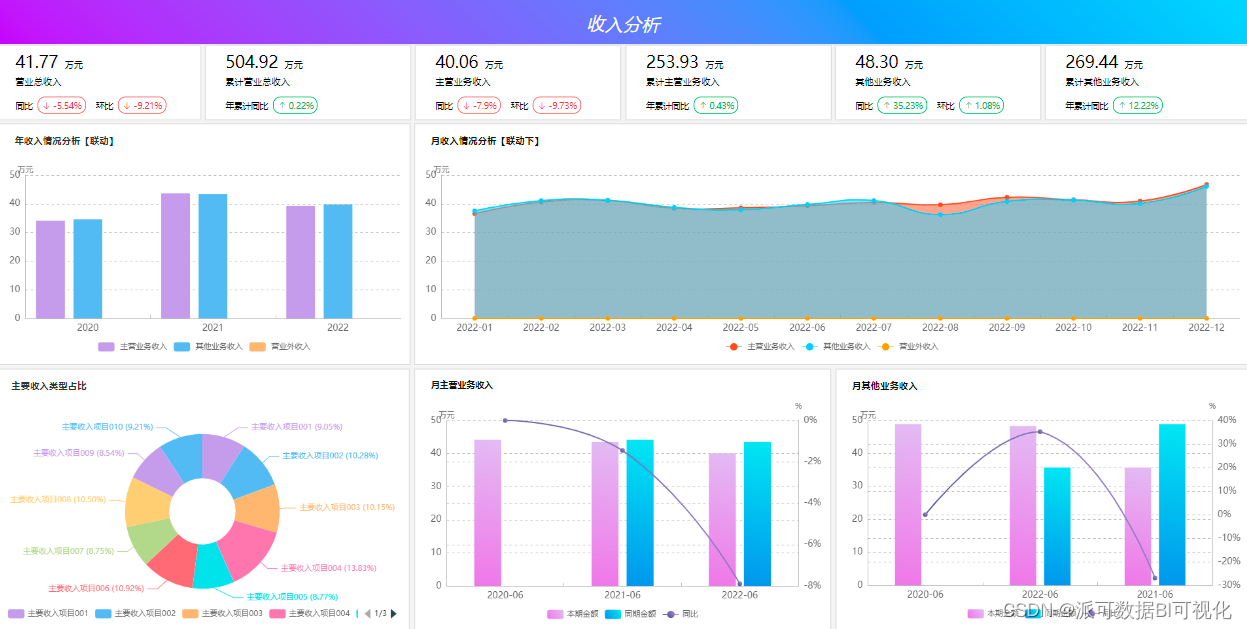
商業智能BI財務分析,狹義的財務分析和廣義的財務分析有何不同?
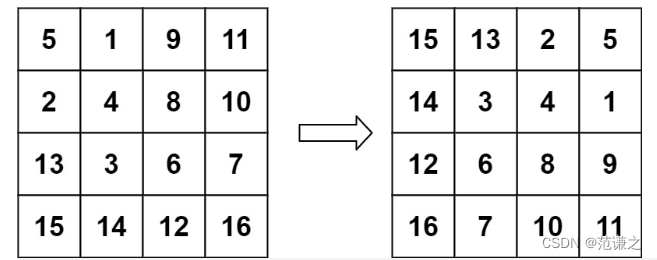
Leetcode T48: rotating images

Innovation and development of independent industrial software
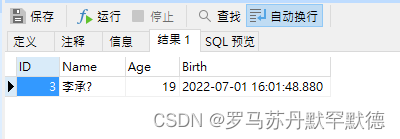
SqlServer函数,存储过程的创建和使用
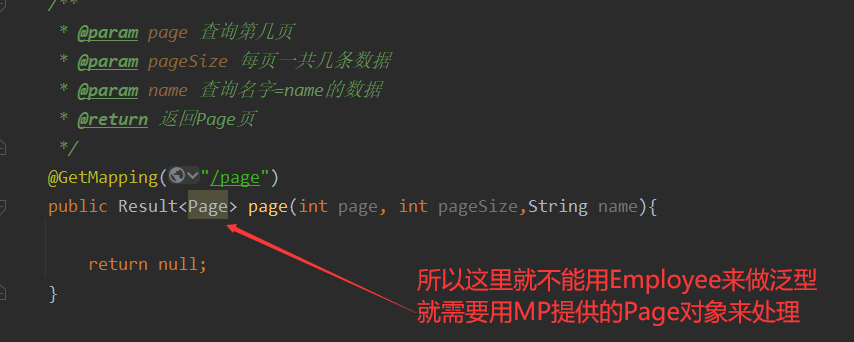
Ruiji takeout notes
随机推荐
Stm32f1 and stm32subeide programming example -max7219 drives 8-bit 7-segment nixie tube (based on GPIO)
The failure rate is as high as 80%. What are the challenges on the way of enterprise digital transformation?
一种架构来完成所有任务—Transformer架构正在以一己之力统一AI江湖
The implementation of OSD on rk1126 platform supports color translucency and multi-channel support for Chinese
Digi重启XBee-Pro S2C生产,有些差别需要注意
C# wpf 实现截屏框实时截屏功能
R language uses the DOTPLOT function of epidisplay package to visualize the frequency of data points in different intervals in the form of point graph, and uses the by parameter to specify the groupin
One architecture to complete all tasks - transformer architecture is unifying the AI Jianghu on its own
LiveData
MATLAB中tiledlayout函数使用
Compile oglpg-9th-edition source code with clion
R语言dplyr包summarise_if函数计算dataframe数据中所有数值数据列的均值和中位数、基于条件进行数据汇总分析(Summarize all Numeric Variables)
docker-compose公网部署redis哨兵模式
实战解惑 | OpenCV中如何提取不规则ROI区域
R语言使用epiDisplay包的dotplot函数通过点图的形式可视化不同区间数据点的频率、使用by参数指定分组参数可视化不同分组的点图分布
AI and Life Sciences
商业智能BI财务分析,狭义的财务分析和广义的财务分析有何不同?
R语言ggplot2可视化:gganimate包创建动画图(gif)、使用anim_save函数保存gif可视化动图
Incremental ternary subsequence [greedy training]
【算法leetcode】面试题 04.03. 特定深度节点链表(多语言实现)